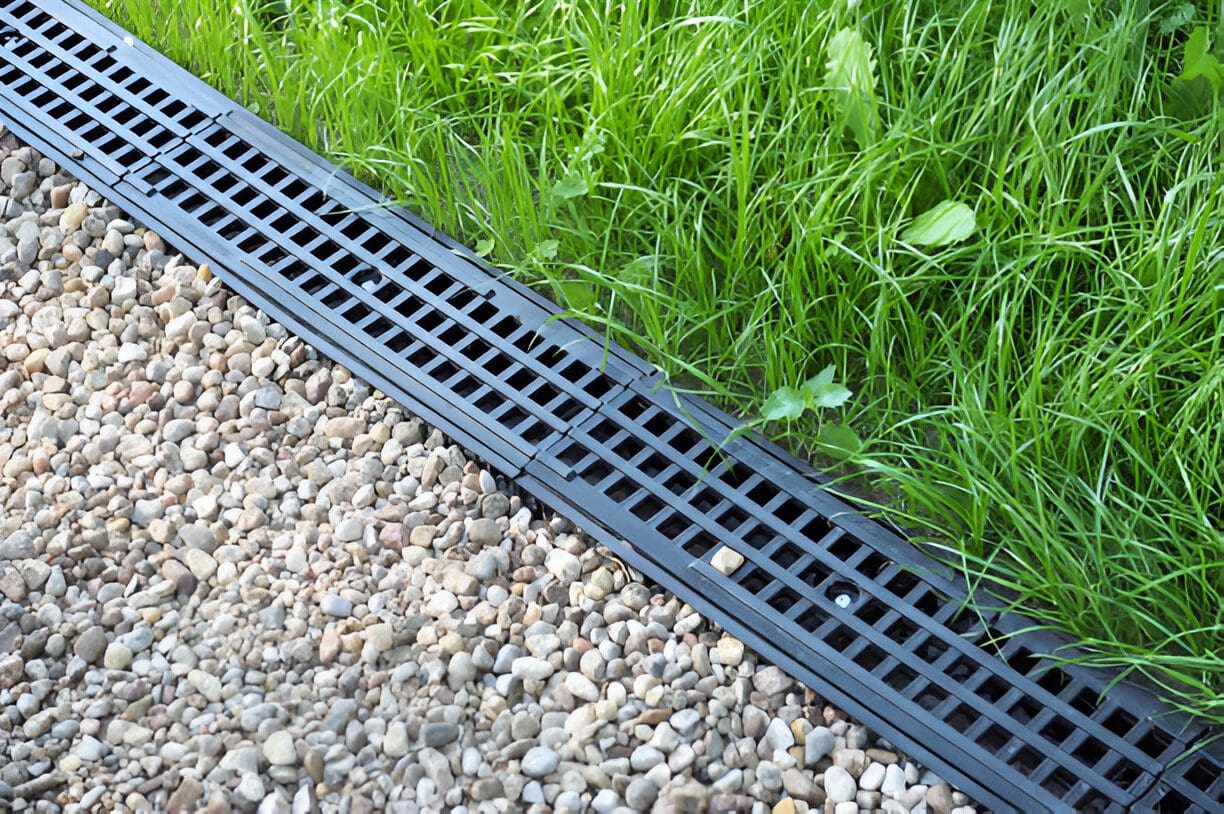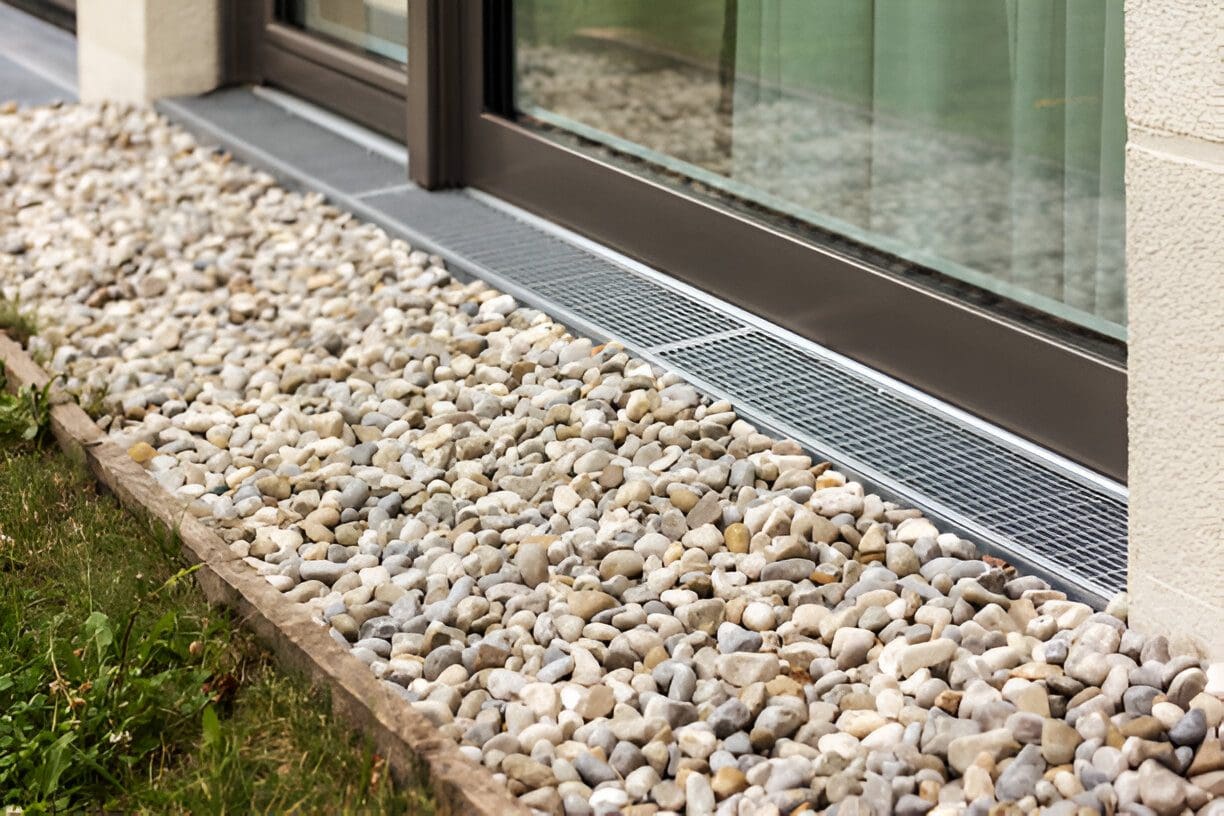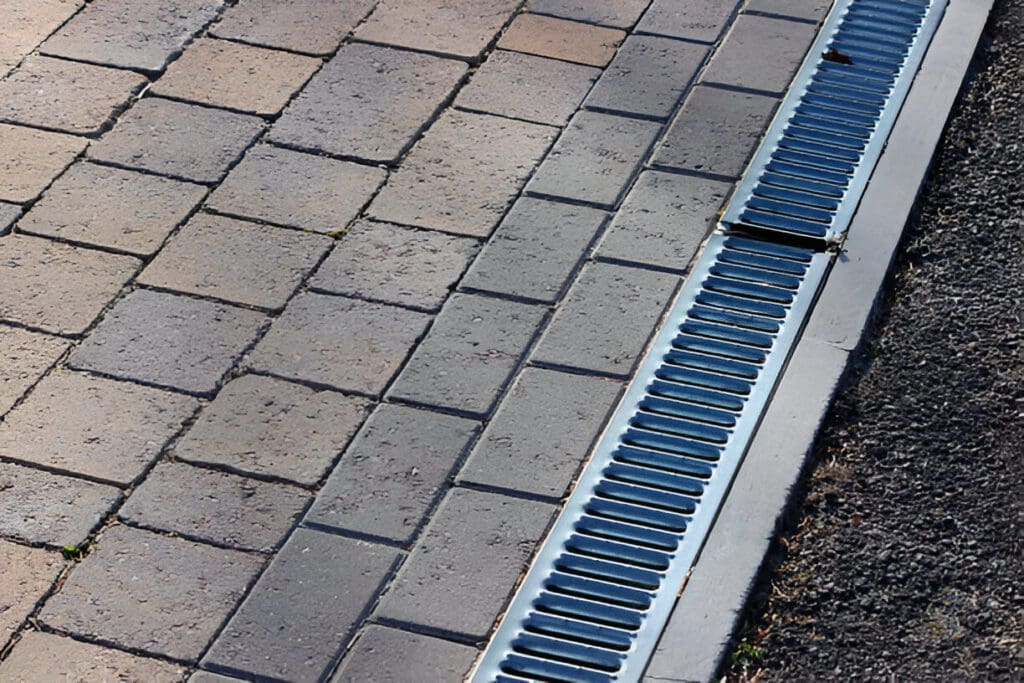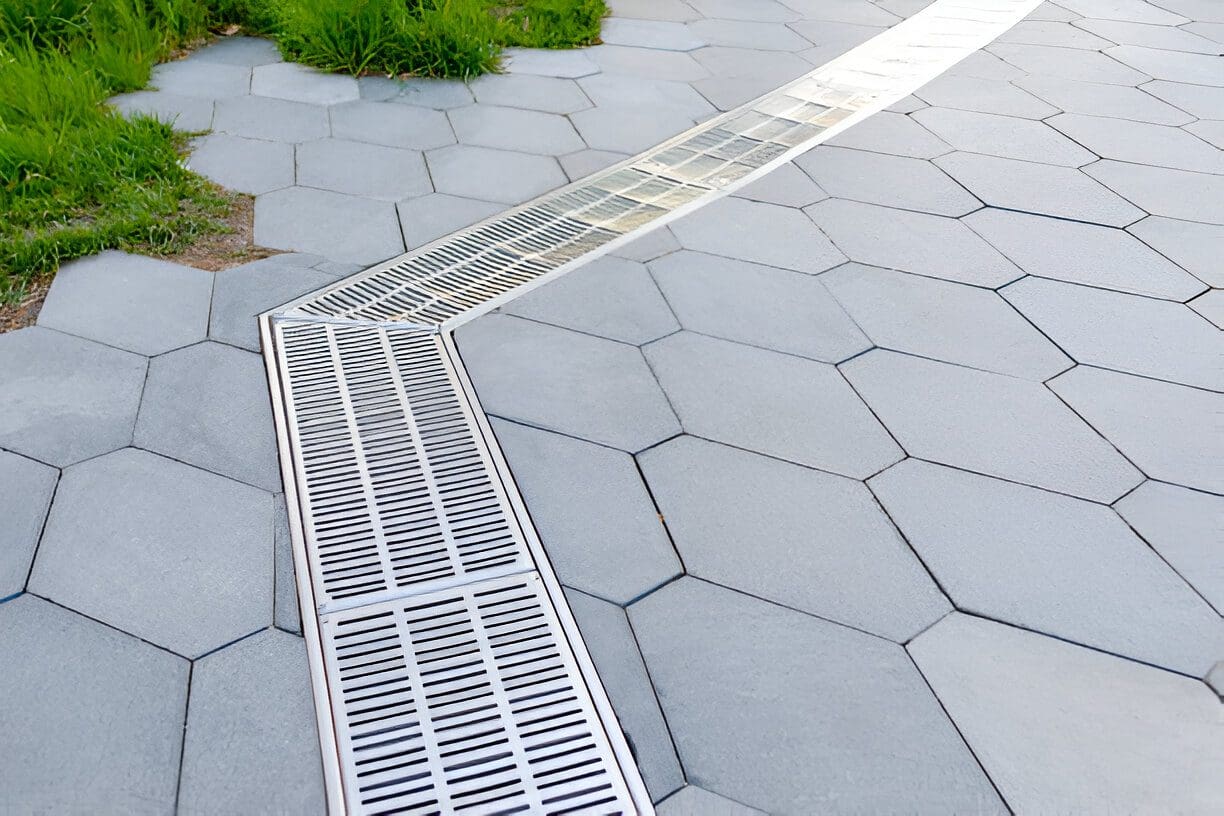A Homeowner’s Guide to Drainage Systems Around the House

Water may be essential for life, but when it collects around your home’s foundation, walkways, or yard, it can quickly become a destructive force. Without a proper drainage system around the house, rainwater and runoff can lead to major issues like soil erosion, basement leaks, foundation cracks, and even mold growth inside your home.
Many homeowners don’t realize there’s a problem until the damage is already done. That’s why understanding how residential drainage systems work, and what your property might need, is so important. Whether you’re seeing puddles form after every storm or planning new hardscaping, this guide will walk you through everything you need to know about protecting your home and landscape with smart drainage solutions.
Why Drainage Around the House Matters
A well-designed drainage system around the house does more than keep your lawn from becoming soggy; it plays a critical role in protecting your home’s structure, landscape, and overall value. When rainwater isn’t properly directed away from your foundation, it can seep into the ground and cause a variety of problems, some of which may go unnoticed until significant damage occurs.
Poor drainage can lead to foundation settling or cracking, water intrusion in basements or crawlspaces, and even long-term structural instability. On the surface, it can create muddy patches in your yard, kill plants, damage walkways, and make outdoor areas less functional and safe. In areas like the Bay Area, where a mix of soil types and sloped lots is common, drainage issues are especially important to address early.
By proactively installing or improving drainage systems, homeowners can prevent water from pooling near the home, reduce maintenance costs, and ensure their landscape and hardscape elements remain in top condition year-round.

Signs Your Home Might Have a Drainage Problem
Drainage issues aren’t always obvious, especially in dry months, but even subtle warning signs can point to bigger problems brewing beneath the surface. If you’re not sure whether your property needs a better drainage system around the house, here are key red flags to watch for:
1. Water Pooling Near the Foundation
After rain, do you notice standing water close to your home’s base? This is a major concern, as excess moisture can seep into your foundation, leading to cracks and structural damage over time.
2. Overflowing Gutters or Downspouts
If your gutters spill over during storms, it’s often because they’re clogged or not draining far enough from the house. Water can erode the soil and pool near entry points into your home.
3. Cracks in the Basement or Foundation Walls
Water that isn’t properly redirected can build up pressure against your foundation walls, eventually causing them to crack or leak, especially in older homes.
4. Musty Odors or Mold Indoors
Excess moisture around the home can lead to mold or mildew in basements, crawl spaces, or even living areas. If you notice persistent damp smells, poor drainage could be the culprit.
5. Soggy Lawns and Erosion
Wet, uneven spots in your yard or visible soil erosion, especially after storms, are often signs that water isn’t draining properly and is damaging your landscape.
By spotting these issues early, you can take the right steps to prevent costly repairs and protect your home from long-term water damage.

Common Types of Drainage Systems Around Homes
Not all drainage problems are the same and neither are the solutions. Depending on your property’s layout, soil type, and water flow patterns, you may need one or more of these common drainage systems around the house to protect your home and yard:
1. French Drains
A French drain is a gravel-filled trench that contains a perforated pipe. It collects excess groundwater and redirects it away from your home. These are especially useful near foundations or in low-lying areas of your yard.
2. Grading and Sloping
One of the simplest but most effective drainage solutions is proper grading. This means shaping the soil around your home so water naturally flows away from the foundation, rather than pooling next to it.
3. Dry Wells
Dry wells act as underground storage tanks that collect runoff and allow it to slowly soak into the surrounding soil. They’re ideal when water needs to be absorbed onsite rather than redirected off the property.
4. Swales
Swales are shallow, gently sloped ditches designed to guide surface water away from structures and toward designated drainage areas. When filled with gravel or plants, they can also serve as attractive landscape features.
5. Gutter Extensions and Downspout Drains
Extending downspouts several feet away from your house prevents roof runoff from saturating the ground near your foundation. Underground downspout drains can be used to move water even farther with minimal visual impact.
6. Channel or Trench Drains
These are long, narrow drains often installed in driveways, patios, or walkways. They quickly capture and redirect surface water across paved or hardscaped areas.
Each of these systems can be customized to suit the unique layout of your property. In many cases, a combination of solutions delivers the best results. Especially in regions like the Bay Area where homes are built on varying terrain.
How to Know Which Drainage Solution Fits Your Home
Choosing the right drainage system around the house isn’t a one-size-fits-all decision. It starts with understanding how water behaves on your property, especially after heavy rain. For instance, if your yard slopes toward your home, water naturally flows in the wrong direction. In that case, grading the landscape or installing a French drain can help reroute runoff away from your foundation.
Soil type is another key factor. Homes built on clay-heavy soil, which is common in parts of the Bay Area, are more likely to experience water retention issues. That makes subsurface options like dry wells or gravel trenches more effective than simple surface-level fixes. If your property has sandy or fast-draining soil, you may need erosion control instead of aggressive drainage infrastructure.
Also consider the areas where water tends to collect, under downspouts, near patios, or along the edge of your driveway. Targeted solutions like downspout extensions or trench drains may be all you need in these zones. And if you’re planning any new hardscaping projects like a patio or outdoor kitchen, it’s wise to design them with drainage in mind from the start. Permeable pavers and sloped surfaces can prevent problems before they start.
Finally, the local climate matters too. While the Bay Area doesn’t get frequent rain, when storms hit, they can be intense. Your drainage system needs to be able to handle those downpours without creating runoff problems that damage your home or landscaping.
DIY Fixes vs. Hiring a Drainage Contractor
If you’ve noticed water pooling around your home or soggy spots in the yard, you might be tempted to handle the problem yourself. And for minor issues, that’s often a great place to start. Simple DIY fixes, like cleaning out gutters, extending downspouts, or adding a gravel channel, can help redirect small amounts of water away from your home’s foundation.
However, drainage issues are rarely one-dimensional. Water may be coming from multiple sources, moving beneath the surface, or pooling in areas where grading and soil composition are working against you. In these cases, DIY solutions may only provide temporary relief, or worse, create new problems elsewhere on your property.
That’s where a professional drainage contractor comes in. An expert can assess your property’s slope, soil, hardscape layout, and rainfall patterns to design a solution tailored to your unique situation. They’ll also ensure the system is installed correctly and up to code, minimizing risk to your home’s foundation and long-term value.
If you’re unsure which route to take, start with an evaluation. A qualified contractor can help you understand whether your issue is surface-level or structural, and which solution makes the most sense in the long run.
Drainage Solutions That Pair Well with Landscaping
A well-designed landscape isn’t just about beauty; it also needs to manage water effectively. Integrating drainage systems around the house into your landscaping can improve both function and curb appeal. For example, decorative dry creek beds can serve as stylish swales, channeling runoff while blending seamlessly into garden designs. Rain gardens are another great option; these shallow, planted basins are designed to collect and absorb stormwater using native plants with deep roots that filter and slow water flow.
Retaining walls can also play a dual role, especially on sloped lots. With built-in weep holes or gravel backfill, they can direct water away from structures while adding structure and interest to the yard. For paved areas, consider incorporating permeable pavers or gravel joints that allow water to seep through rather than pooling on the surface. These types of solutions make your landscape not only look great but also work smarter, keeping your home and yard drier year-round.
How Poor Drainage Affects Hardscaping
Without proper drainage, hardscaped areas like patios, walkways, and outdoor kitchens are vulnerable to long-term damage. When water has nowhere to go, it can pool on surfaces, seep beneath pavers, and erode the base layer underneath. This often leads to uneven settling, cracks, or even full structural failure over time. Freeze-thaw cycles, where moisture gets trapped in joints or cracks and then expands, can accelerate this wear.
In extreme cases, poor drainage can even undermine expensive features like outdoor kitchens or built-in seating areas. Electrical components may corrode, paving stones may shift, and soil erosion can lead to instability. That’s why installing a drainage system around the house is crucial when adding or upgrading any hardscape. With trench drains, sloped surfaces, and water-permeable materials, you can protect your investment and extend the life of your outdoor living spaces.

Protect Your Home with the Right Drainage System
Whether you’re dealing with soggy soil, foundation concerns, or pooling water near your patio, addressing drainage issues isn’t something to delay. The right drainage system around your house helps protect your property from costly damage, improves the longevity of your landscaping and hardscaping, and keeps your outdoor spaces more usable year-round.
If you’re unsure where to start, Kiwi Pavers is here to help. Our team specializes in designing and installing drainage systems that work seamlessly with your existing yard and outdoor features. We understand the unique challenges Bay Area homeowners face, and we know how to build solutions that last.
Contact us today to schedule a consultation and take the first step toward a drier, healthier home.

